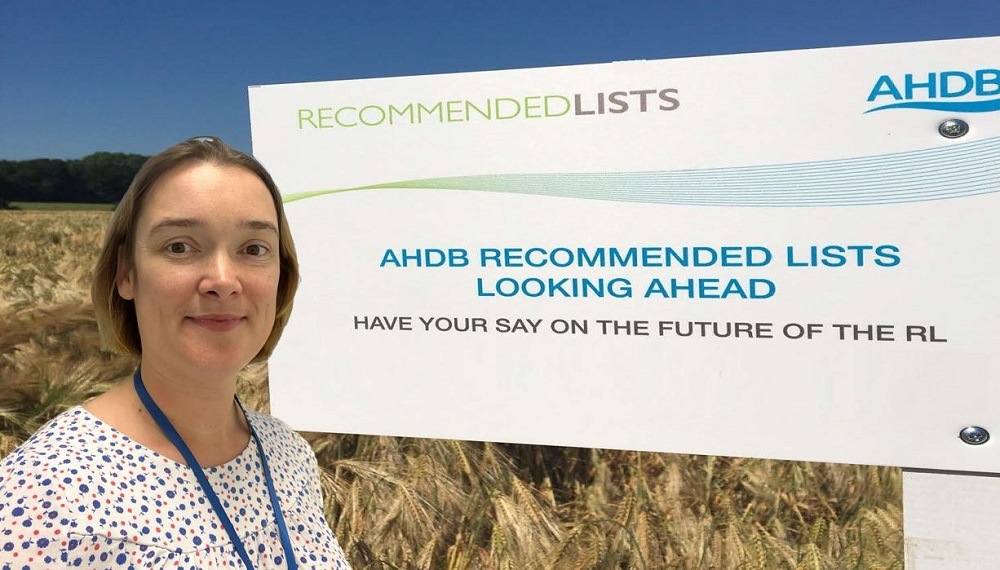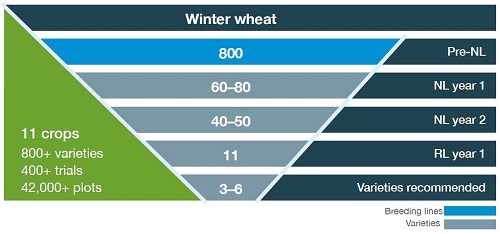Podcast probes Recommended Lists review
Wednesday, 18 January 2023
The latest Food & Farming podcast by AHDB Cereals & Oilseeds investigates a major review of the Recommended Lists (RL). The Q&A format explores the variety trialling project, why a review is necessary, and how you can get involved.
The RL review: everything you need to know
In the podcast, Jason Pole talks to Jenna Watts, who leads on integrated pest management (IPM) research at AHDB. Listen in or read the transcript below.
Jenna, what do you do at AHDB?
I lead the Crop Health and Integrated Pest Management (IPM) team. The team manages many activities, including disease monitoring, fungicide performance trials, grain contaminants monitoring, and, of course, the Recommended Lists (RL).
In a nutshell, what is the RL?
The project is run in partnership with the British Society of Plant Breeders (BSPB), the Maltsters Association of Great Britain (MAGB) and UK Flour Millers (UKFM).
It covers 11 crops and delivers the trials, tests and analysis required to deliver independent information on variety performance in recommended or described lists.
The lists detail many characteristics, such as yield, with and without fungicide treatment, grain quality, resistance to key diseases, and assessments of agronomic traits, such as resistance to lodging. Information is made available in several ways, including a printed publication, app, and web tools.
Why does the RL need a review?
Previous reviews and the recent Shape the Future activity show that the RL is a valued and an important resource for growers. However, we don't want to rest on our laurels. We need to identify improvements, so the RL stays valuable and becomes more valuable. For this reason, the AHDB Cereals & Oilseeds sector plan includes a commitment to conduct a major review of the RL in its current project phase.
You were involved in the last RL review, is that right?
Yes, indeed it is. The RL ‘look ahead’ review concluded in 2019. The information gathered has been used to guide activity, from trial approaches to how recommendations are made.
What did you learn last time around and, more importantly, how did the RL change?
The last review highlighted the need to consider the whole variety package, rather than headline yields. It resulted in many changes within the RL system. This included changing the way certain traits are evaluated and presented, such as disease resistance and lodging. We also developed digital formats, including the variety selection tools and the RL app.
Does the latest review cover all activity or are there areas of focus?
The RL is a large project with lots of moving parts. However, we aim to review the whole project. It is an ambitious review.
Are there particular groups of people that you’d like to get involved?
We are keen to hear from everyone that uses the RL and we're running several activities.
One of the easiest ways to participate is through the questionnaire. I encourage as many people as possible, especially farmers, to complete it. It is a fantastic opportunity to have your say on the RL. You can tell us what's important to you when making a variety selection decision, why you switch varieties and your view on the RL publications and outputs. There are free text boxes too, where you can add your own ideas and comments.
Subscribers to the RL print mailing will receive a paper copy of the questionnaire, alongside their booklet, later this month. However, anyone can download a copy from the AHDB website and return it via post or simply complete the digital form.
There are meetings taking place this winter, can you tell us about those?
Yes, we've got focus groups set up that take place from the end of January into February. Aimed at farmers and agronomists, they provide a way to drill down into more detail on the results coming from the questionnaire responses. For others interested in the RL, we're also running a series of stakeholder interviews.
Who's responsible for making sense of the results and recommending how the RL changes?
We’ve set up a dedicated steering committee to lead the project and provide recommendations to AHDB. The group features a mix of people covering many areas, including agronomy, pathology, plant breeding and grain processing.
Without the results, the final question may be difficult to answer: how long will it take to make changes after this phase of the review is complete?
That is a difficult question. In a nutshell, some changes will be easy to implement and achieved in the short term. This could include changing the way some data is analysed. Some changes would take longer. For example, if we wanted to provide information on a new trait. In this situation, a new trial series may be needed, and it could take several years to generate the robust data required.
 AHDB
AHDB
 AHDB
AHDB
Complete the RL review questionnaire (online)
What do you recommend?
The RL in numbers
More than £25 million invested*
£12,832,434 AHDB investment
£12,309,850 industry investment
 AHDB
AHDB
*Investment figures based on the 2016–2021 RL project. Crop and variety figures based on typical annual numbers. NL = National List.
RL review focus groups
The online focus groups provide the perfect opportunity to discuss the variety trialling project and how to adapt it to meet the evolving needs of modern farming businesses.
The online meetings are primarily aimed at farmers and agronomists, with the agenda guided by the emerging results of the RL review.
The facilitated discussions will explore how farmers make variety selection decisions and address pressing challenges to ensure that the RL’s limited resources focus on what delivers the best value to industry.
You are welcome to contribute as much or as little as you like to the focus group discussions.
Simply listen in or provide your ideas – it is up to you.
Event booking links
31 January 2023 (8:00am–9:30am) – organic focus
 questionnaire.JPG) AHDB
AHDB
Topics:
Sectors:
Tags:



.jpg)